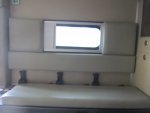rlrenz
Explorer
Everything I find regarding ambulance construction repeatedly shows me that the darn things are built like brick phone booths. The big advantage we have is that they are all built to the same GSA standards, so even though there are always differences in how each maker does things, there will always be a lot of commonality--eg: the type of wire used, the use of convoluted tubing, the type of upholstery, relays with diodes for control in anything built before about 200/2001. ALL the makers tended to use the same components -- interior lighting by Weldon, exterior lighting by Weldon, or Guide, and emergency lighting by Whelen, Code-3, and Federal.
Oddly enough, I found the document when I was searching for Freightliner AM/FM radio antennas - I want to add an AM/FM/CD radio to the module, and I was looking for a comparable antenna. I had never seen the document when I searched for Medic Master.
Pat: Are you sure you don't have laminate covering? Unless the surface is definitely soft, you may have a solid color laminate. Check WIlsonart - they seem to be heavily into industrial / commercial applications.
I have a couple of the reading lights on order. I'll run some photos and my $0.02 worth of opinion when I have them. I ordered mine from a Weldon distributor that I use who had to order some in, but they are also available from Emergency Responder Products (http://www.emergencyresponderproducts.com/82ledswrela.html) for $ 16.95
Oddly enough, I found the document when I was searching for Freightliner AM/FM radio antennas - I want to add an AM/FM/CD radio to the module, and I was looking for a comparable antenna. I had never seen the document when I searched for Medic Master.
Pat: Are you sure you don't have laminate covering? Unless the surface is definitely soft, you may have a solid color laminate. Check WIlsonart - they seem to be heavily into industrial / commercial applications.
I have a couple of the reading lights on order. I'll run some photos and my $0.02 worth of opinion when I have them. I ordered mine from a Weldon distributor that I use who had to order some in, but they are also available from Emergency Responder Products (http://www.emergencyresponderproducts.com/82ledswrela.html) for $ 16.95


